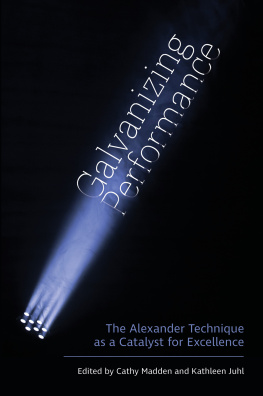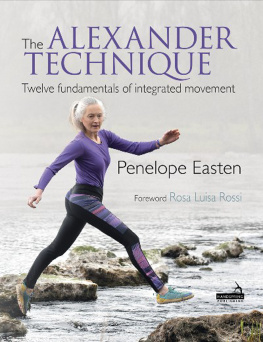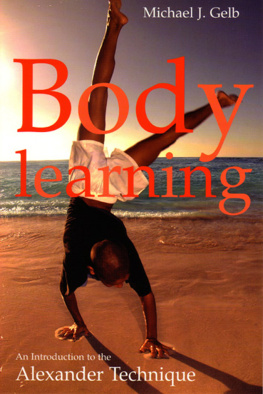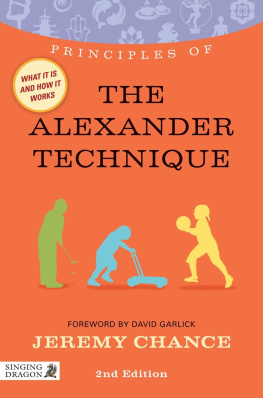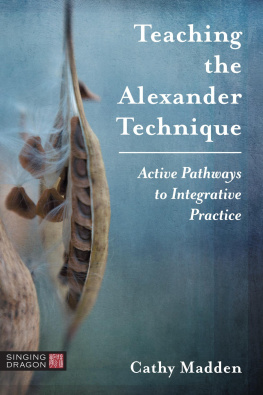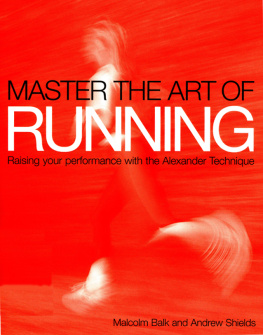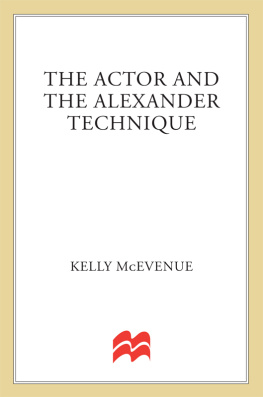
Galvanizing
Performance
The Alexander Technique
as a Catalyst for Excellence
Edited by Cathy Madden and Kathleen Juhl

Contents
Introduction
Galvanizing Performance fills a need that until now has had expression only in specialty journals such as Direction , members-only publications of various Alexander Technique societies, and proceedings from the International Congresses of the Alexander Technique. The writings in this book are from teachers of the Alexander Technique (abbreviated throughout the book as AT) about the teaching process itself. Virtually all of the published literature explains the technique in some way, either on its own or in relationship to specific endeavors, such as performing arts or sports. However, the extant literature does not directly address the details of teaching AT. We get merely indirect, anecdotal glimpses of the teaching process.
What is missing in the literature are the voices of teachers who came after F. Mathias Alexander himself. It is our position that new approaches to teaching AT should be brought to light. The state of the art of teaching AT is evolving, and a great many teachers have done day-to-day, experiential, and heuristic research on what works well. Their research exists in disparate articles and anecdotes in books on particular topics. (Maddens book Integrative Alexander Technique Practice for Performing Artists: Onstage Synergy (2014) is an example.) Galvanizing Performance brings together the insights of an eminent group of teachers on the subject of teaching performers, revealing the specific details of how AT is taught.
Why teachers of performers? Because of the nature of performance training, some AT teachers represented in this book have taught the same individuals not for weeks or months, but for many years in venues such as university graduate programs and private practice. It is not unusual for these teachers to have had multiple generations of students. Over those years, they have had the opportunity to test new, innovative teaching approaches.
We want to more effectively preserve and disseminate the work of these pioneering teachers. This enables the next generations of teachers to build from the foundation their predecessors have so innovatively developed. Many of the chapters allude to the fact that new generations of students in all fields (not just the performing arts) are asking new questions and coming up with new puzzles and difficulties as they approach issues connected to what Alexander called psychophysical unitywhat some call the mind/body problem. The teachers in this book have novel ways of addressing these conundrumsit turns out that AT, as John Dewey said, bears the same relation to education that education itself bears to all other activities (Alexander 1984 [1932], p.xix).
While the focus of this book is on teaching performers, the teaching ideas are widely applicable to other activities.
An Introduction to AT
For those of you reading this collection who are new to AT, this introduction offers a general background for the work and teaching process.
AT is a psychophysical change process using conscious thought to restore coordination and/or prevent miscoordination in human functioning. What F.M. Alexander (18691955) observed empirically is that the relationship between head and spine in movement is a key factor in vertebrate coordinationa fact that has subsequently been verified scientifically. Whenever a vertebrate goes out of optimal coordination, the system compensates with excessive work in the relationship between head and spine. Frank Pierce Jones, a Tufts researcher who studied AT, says in his book Freedom to Change :
F. Mathias Alexander discovered a method (a means-whereby) for expanding consciousness to take in inhibition as well as excitation (not-doing as well as doing) and thus obtain a better integration of the reflex and voluntary elements in a response pattern. (Jones 1997 [1976], p.2)
The goal of AT is to teach people to restore an optimal relationship between head and spine, and, when necessary, replace faulty concepts that cause the miscoordinationwhat Alexander called mistaken beliefswith more accurate, constructive concepts. The results of this process include greater flexibility and grace in movement and speech, clarity of thought, and, for many, absence of physical pain and stress patterns. Again from Jones:
The Alexander Technique opens a window onto the little-known area between stimulus and response and gives you the self-knowledge you need in order to change the pattern of your responseor, if you choose, not to make it at all. (Jones 1997 [1976], p.4)
It is in this miniscule moment of time, the area between stimulus and response, that true honesty and creativity can emerge. As long as our responses are mitigated by habitual, unconsciously driven miscoordination, both what we think and what we express fall short of what is possible.
The causes of miscoordination include but are not limited to:
imitation of family patterns
imitation of teacher/mentor patterns
mistaken ideas about anatomy and physiology
learned patterns (e.g. from sports, music, or other training) that are misapplied to another activity
attempts to use muscular contraction for tasks that do not require muscular contraction
mistaken concepts about thinking
compensation for injury (possibly compensation that is no longer necessary)
trauma
emotional armoring
learned misuses, which F.M. Alexander calls cultivated habits
electronically raised concepts of thinking and moving.
The sequence of teaching and learning AT involves an analysis of movement and thought in relationship to the desired goal, followed by synthesis of a constructive conscious plan for change and accomplishment of that end.
How It Is Taught: The AT Teaching Process
What we recognize as good coordination in human movement and behavior is recognizable as fluidity in movement, appropriate muscle tone for the activity, and clarity of thought and intention. This combination of qualities generates behavior illustrative of words attributed to A.R. Alexander (F.M.s brother): The hallmarks of the Alexander Technique are creativity, spontaneity, and adaptability to change. Ichiro Suzuki provides a model of what this kind of coordination looks like in baseball. Baryshnikov, in ballet, and Michelle Kwan, in figure skating, are other examples.
The teacher of AT needs to create the conditions in which these qualities can emerge from each student. The first tool is the teachers own coordination. One of the unique factors in teaching this work is that the teacher herself must be using AT in order to effectively teach it. The teachers own coordination functions in several ways:
It provides a clear model of coordination for the student to imitate (possibly related to recent discoveries of mirror neurons).
A clear coordination enables teachers to use their hands skillfully in teaching to guide the students change process.
Good coordination heightens the teachers ability to observe, listen, and analyze.
A psychophysically clear coordination enhances the teachers creativity, spontaneity, and adaptability to change in the teaching process.
The tactile communication within AT is a primary way the teacher can help the student directly understand that thought and movement are inseparable. Teachers are trained to use a unique and refined system of teaching tactilely, communicating through a combination of light, informed touch and brief verbal cues. With the skillful use of their hands as an extension of verbal communication, AT teachers show their students how to make this association themselves. Most importantly, each teachers full self-coordination models most profoundly the absolute unity of mind, body, and intention.
Next page
